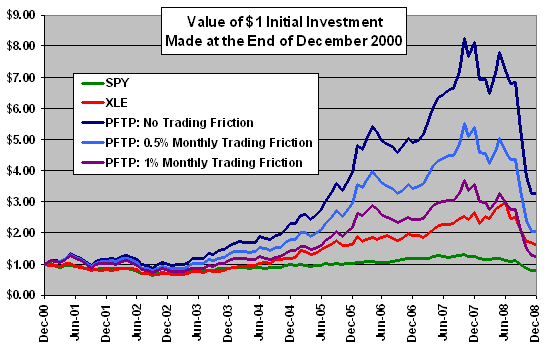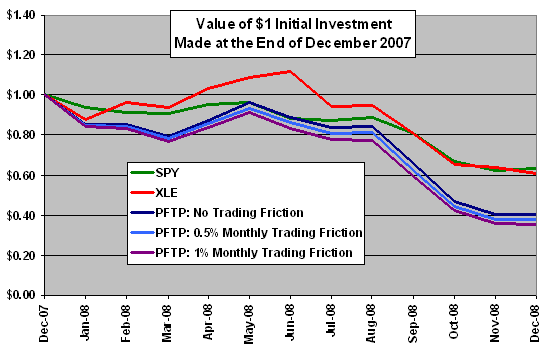In their 2008 book, Profit from the Peak: The End of Oil and the Greatest Investment Event of the Century, Brian Hicks and Chris Nelder examine the equity investment implications of a growing gap between a post-peak worldwide supply of energy from fossil fuels and a rising international demand for energy. They identify more than 70 companies that, in their judgment, are best positioned to exploit declining oil and gas supplies or “energy alternatives poised to power the years ahead.” How have the stocks of these companies performed over the past few years and in the very recent past? Using monthly dividend-adjusted return data for the recommended stocks as available from Yahoo!Finance for the period December 2000 through December 2008, we find that:
We located the following 71 “best positioned” stocks in Profit from the Peak (symbols modified or corrected to match those currently used in Yahoo!Finance):
VLO, TSO, RIG, DO, SLB, HAL, BHI, SUF, ECA, CHK, SWN, BTU, ACI, RTK, SSL, SU, WSS.DE, PCA.TO, UTS.TO, TCK, ANDE, PEIX, ABDS.OB, GSHFE.OB, VCTPF.OB, VSE, AVR, ADM, STKL, MGPI, ASYS, WFR, ENER, FSLR, SPWRA, AKNS, OEGY.OB, XTX.TO, ORA, RZ, HTM, UTX, CCJ, USU, URZ, PMFG, EEI, ENOC, DESCQ.PK, BCON, GE, COMV, ITRI, ELON, GAM.MC, IBE.MC, ZOLT, VWS.CO, ANA.MC, CWP.L, MIH.F, 532667.BO, FCEL, PLUG, BLDPD, BNI, UNP, NSC, CNI
Yahoo!Finance offers no historical price data for a few of these stocks (introducing some survivorship bias), and only very short histories for several others. Some appear to be very illiquid. To investigate the aggregate performance of these recommendations, we make the following assumptions to construct a portfolio of the stocks (the PFTP portfolio):
- Begin analysis with the new century (adjusted closing prices at the end of December 2000).
- Add new stocks as available based on the adjusted close of the first month listed.
- Assume an equally-weighted PFTP portfolio, rebalanced monthly. (Note that the authors comments on individual stocks might suggest portfolio approaches other than equal weighting.)
- Construct scenarios with trading frictions (trading fees plus bid-ask spreads plus impacts of trading) of 0%, 0.5% per month and 1% per month to test sensitivity to costs of rebalancing/accommodating new stocks as listed.
- Use the S&P 500 index mimicking SPY and Energy Select Sector SPDR (XLE) as benchmarks.
The average monthly return of the PFTP portfolio based on these assumptions is +1.6% with no trading frictions. Monthly trading frictions of 0.5% (1%) per month reduce this average to +1.1% (+0.6%). By comparison, the average monthly returns for buying and holding SPY and XLE over this same period are -0.2% and +0.7%, respectively. The standard deviation of monthly returns for the PFTP portfolio is 8.1%, compared to 4.3% for SPY and 6.5% for XLE. Depending on actual trading frictions, buying and holding XLE might be more attractive than the PFTP portfolio.
For a different perspective, the following chart shows the performance of $1.00 initial investments in the PFTP portfolio (three scenarios), SPY and XLE starting at the end of December 2000. The results show the sensitivity of PFTP portfolio performance to trading friction. The performance of XLE roughly matches that of the PFTP portfolio with 1% monthly trading friction.
Profit from the Peak became available to the public in April 2008, so the PFTP portfolio was probably firm by about the beginning of 2008. How has the portfolio performed outside of any backtesting/selection sample?

The next chart shows the performance of a $1.00 initial investment in the PFTP portfolio (three scenarios), SPY and XLE starting at the end of December 2007. During this very short out-of-sample period, the PFTP portfolio has generally underperformed both XLE and the broad market. However, a test of many years is appropriate for the theses laid out in the book.
Short cumulative performance tests are very sensitive to the start date.

Note that the above analyses make no attempt to account for possible survivorship bias due to missing data. This bias favors the PFTP portfolios.
In summary, Profit from the Peak offers a range of stock recommendations to exploit a long-term energy shortage, but historical data suggest that a portfolio constructed from these stocks may be quite volatile with some big hits and big misses. These stocks, equally weighted, have underperformed the broad stock market out-of-sample.